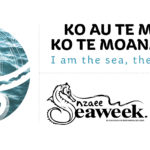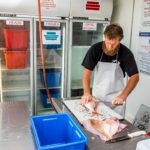Conservationists are calling for continued action amid the increasing impact sediment is having on giant kokopu, one of Auckland’s rarest whitebait species.
The urgency comes from Auckland Council’s Freshwater Senior Regional Adviser Matt Bloxham, who says “Auckland doesn’t appear to have enough giant kokopu stream (source) populations to maintain high recruitment, because oceanic larval stocks are becoming depleted.”
Like other whitebait species, the young of giant kokopu spend time developing in the ocean before returning to adult habitat as whitebait in spring. “As adult populations are lost, we potentially add to this problem by reducing the oceanic larval pool and therefore also recruitment back into adult stream habitat.” Matt adds, “It’s akin to young kiwi folk going off on their OE but never returning home. Fewer young fish come back, the population ages and eventually dies out”.
This sediment issue is implicated in the noted decline of giant kokopu populations nationally and throughout mainland Auckland.
A remnant population at West Hoe Heights in Orewa was lost recently due to unmitigated sediment loss from a housing development into a nearby giant kokopu wetland. The Nukumea population in the neighbouring catchment is now coming under similar pressure.
A recent stocktake of known giant kokopu sites on the mainland found no fish at any of the 25-former giant kokopu sites. A handful of new (mainly island) sites have been found since, but they contain on average fewer than half a dozen fish and in some streams, a solitary fish remains.
However, the discovery of three geographically overlapping giant kokopu ranges on the south-eastern corner of Waiheke Island and another in Waitakere Regional Park increases the prospect of the species enduring in Auckland.
The first population found was in Awaawaroa Wetland in 2014, which resulted in the local community and Council mobilising to restore the population. More recently, there have been populations found in the neighbouring catchment to the east of Awaawaroa, and at Whatipu in the Waitakere Ranges.
However, a third population to the west of the Awaawaroa system, Whakanewha Regional Park, has recently disappeared “we think because of sediment loss from a gravel road higher up the catchment”, says Matt.
It turns out the population found to the east of Awaawaroa is the largest we have left in the region and the juveniles it disgorges into the ocean are likely to bolster the two nearby giant kokopu wetland populations.
“But even the largest population may become compromised if the two smaller populations (Awaawaroa and Whakanewha) are allowed fall away (i.e. it is likely that all 3 populations are underpinned by the same oceanic larval supply).
“While we will have to restock Whakanewha, if we act quickly and seal the sections of road that contribute sediment to Whakanewha, Whatipu and Awaawaroa, we may be able to sustain all three fisheries.”
“Major stochastic storm events of the type we are expecting more of with climate change have the potential to generate considerably more sediment and compromise kokopu populations in these rural and peri-urban environments. We are grappling with that at Awaawaroa, Whakanewha Regional Park, at Whatipu and in and around Orewa, where the species’ exposure to suspended sediment is high, particularly from roading.”
Matt says, “while gravel roads aren’t the only sediment source, they are one of the key sediment contributors in two of the Waiheke wetlands and are putting giant kokopu under particular pressure there”.
Mr Bloxham says “because the gravel on Waiheke has a high clay content, it only adds to the problem. Fine sediment is remobilized with every vehicle movement and stored in loose uncompacted drifts within the road corridor. At Whatipu, Whakanewha and at Awaawaroa, the close proximity of the gravel roads to their respective receiving freshwater environments means there’s very limited opportunity to intercept/settle out the sediment before it reaches the waterway and sealing is really the only option,” he said.
Auckland Council is responding to the issue of sediment loss to waterways from bulk earthworks sites and is working tirelessly to combat every angle of the issue. Matt says, “parallels can be drawn between earthwork sites and unsealed (gravel) roads. However, over their lifetime, dirt roads have the potential to be considerably more impactful as there are no sediment controls and release persists for as long as the roads prevail, whereas bulk earthworks are usually relatively short-term activities.”
Auckland Council aided by Forest and Bird, Conservation Volunteers NZ and the local community are working urgently to address the other threats to the island’s wetland populations, which include habitat loss and predation.








